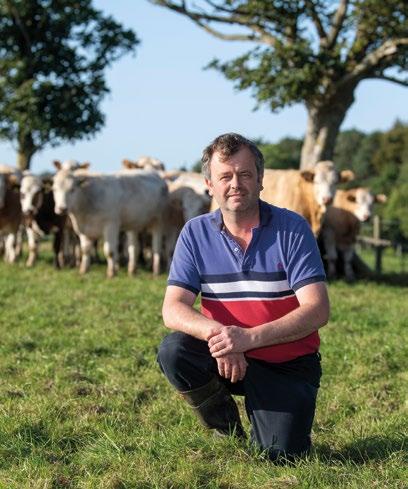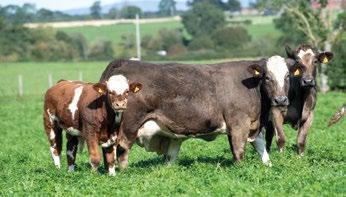
9 minute read
Spotlight on Cumbria
SIMMENTALS THE BREED ‘FIT TO FACE THE FUTURE’
AT MANOR FARM, PENRITH
Advertisement
The Review features the 120 suckler cow herd of Irving & Evonne Pearson at Manor Farm, Blencow, Cumbria where lower input Simmentals are helping to increase profitability.
Based on the very edge of the fertile Eden Valley in the small hamlet of Blencow, in the shadow of the eastern mountains of the Lake District near Penrith, Cumbria, Irving Pearson farms Manor Farm with his wife Evonne. Irving is following in the footsteps of his great grandparents who took the tenancy of the farm on back in the mists of time and which now runs to 320 acres of productive farmland with about two thirds of this owned, and the rest rented. The Pearsons run around 100 Texel cross bred ewes, a project that his children, Lilia, 11, and Isaac, 9, are ‘in charge of’, and which has quickly grown from the starting point of a couple of ewes. Being in such a fertile area they also grow around 50 acres of barley, which helps with the winter feed and bedding, and also helps keep the ground fresh and in good heart, reseeding with grass after cropping.
The main focus of the farm however is on their herd of 120 suckler beef cows, a mixture of pure Simmental and British Blue cross Simmental which run with the Simmental bull, producing top quality beef cattle which are all retained and finished on the farm. “We put a few pure Simmentals to the British Blue bull with a view to retain some of the resulting heifers for breeding and there is a market for our surplus heifers too” Irving observes.


Pre foot and mouth in 2001, the farm was using Limousin sired cattle out of dairy cows, but when the Pearsons re-stocked they re-evaluated the business and decided to look for a beef breed with a bit more carcase and quicker finishing time than they were achieving with the Limousin cross. Having looked around they settled on the Simmental bull as their main sire, liking them for their carcase, mothering ability, and the fact they were very quiet to handle. “They are a genuine Dual Purpose breed” says Irving, “Well fleshed and fast finishing, but the females are great milkers too, an ideal starting point for a modern suckler cow” he says. Today they run an essentially closed herd, retaining 16-20 of the best females annually, which are calved at three years old to an easy calving bull, and just buying in fresh bulls when required. “Keeping the herd closed as much as possible helps keep the herd healthy and saves us bringing in unforeseen in problems. When we look for a new bull a high health

status is as important as the bull himself” he notes. As well as keeping an eye on the health status of incoming cattle they also vaccinate against BVD and leptospirosis which is seen as a vital tool to keep the herd disease free.
The herd calves in spring mainly to utilise the best of the grass and all the calves, apart from the heifers that they select to retain, are finished on the farm. The calves get a good start and summer well as Irving finds the cows are such good milkers off the grass. Once weaned and housed in the autumn, the bulls are finished on a diet of barley and a 34% protein pellet. With the Simmental breed being well noted for its high growth rate, the bulls are sold at between 12-14 months old direct to slaughter on a deadweight basis, and aiming for a carcase weight of around 400kg. These Simmental sired bulls finish well on this system, fleshing up quickly and meet the specification with ease, mainly hitting the U Grade for maximum profitability. The heifers are grazed around on grass for a second summer and then housed for winter and finished on the same ration as the bulls, selling these at around 20-22 months old, and with them finishing equally as well as the bulls.
When buying a fresh stock bull Irving likes to study the catalogue closely and likes to check out the EBVs for calving ease, milkiness as well as growth as he feels the maternal values of the bull is vitally important for the system he uses, and he sees the EBVs as a tool for selection, but as he says “ I have to like the look of the bull too….. no good having a bull with all the correct figures if you don’t like the look of it….It will hopefully be working here a long time so it has to look the part too!” Whilst he has bought bulls at Carlisle in the past, Irving’s last few bulls have been bought out of Stirling, where he feels there is also a wide range of bulls to choose from and a great depth of quality amongst the bulls on offer.
Looking back over the last 20 years or so with the Simmental as the cornerstone to their herd, Irving hails the Simmental as an ideal breed to fit into his system. “My system might not fit everyone, but it certainly works for us on our farm, and that’s what we set out to achieve when we had to make the change after FMD in 2001” he muses. As farming moves forward to a less certain time post Brexit and less government support, Irving feels the Simmental is a breed fit to face the future with its ability to produce cattle with lower inputs and high growth rates off milk rather than lots of concentrates. This he says therefore lowers costs whilst increasing profitability, offering the Simmental a competitive edge over other breeds.


SIMMENTAL LUING CROSSES EXCELLING AS ‘IDEAL UPLAND CATTLE’

AT TOWN END FARM
Snapshot herd feature on Angus Freeman, Town End Farm, Troutbeck, Lake District National Park.
Set in the heart of the magnificent Lake District National Park, overlooking Windermere from the heights of the historic Troutbeck village is Town End Farm, run by Angus Freeman. It is hard to imagine a more picturesque setting for a farm anywhere in the country. Despite the beautiful setting, it is nonetheless a proper hill farm, and the stock it carries has to be able to cope with whatever the weather throws at it.
The family took on the tenancy of the farm in 1971, when Angus’s father, Doug, took on the farm from the National Trust. Doug was still a regular on the farm up until recently, but had taken more of a backseat to the running of the farm when Angus came back to work full time on the farm in 2008, after spending six years working as a mechanic at C.T. Hayton’s, a local tractor dealership and engineering firm. Town End now runs to around 700 acres of tenanted and owned land, running from the shores of Windermere to the top of Wansfell which rises to 1500 feet above sea level. The Freeman’s lamb about 750 ewes, with 400 Swaledale and 350 mule ewes. The Swaledales, are mainly home bred and any extra replacements that are needed are bought in as gimmer lambs.
Running alongside the sheep is a herd of Luing cattle, which were initially introduced in 2009 when Angus initially bought six heifers from the Cadzow Bros on Luing at a sale in Oban. The herd runs to 30 cattle now, nearly all of them sourced from the same herd on Luing. “We found the cattle ideal for what we need. They thrive on the rough ground and are very quiet, important in the lakes where you may be approached at any time by walkers or mountain bikers whizzing past” he says. They used to have a herd of Limousin cattle
but feel that the Luings perform better, with wintering being cut from 8 months with the Limousin to a mere 3 months with the Luings. The cattle come in between Christmas and New Year and are out again by late March. The first heifers were crossed with a Limousin bull which they still had after selling the herd, but Angus felt that the calves weren’t an improvement on the original Luings. In looking for an alternative, they have been delighted with the Simmental bull, and influenced by the reputation of Simmental – Luings as an ideal cross. Calving is in late February/March, and heifers calve at around 3 years old. Spring calving fits the farms system as the cows can graze, and more importantly, thrive, on the fell during the summer months without any extra intervention.
The Freeman’s sourced a Simmental bull from the Denizes herd of Michael Barlow, Ulnes, Nr Leyland, Lancashire with the herd high health status being extremely important. Extremely impressed with the quality of the calves and the ease of calving, further Denizes bulls have subsequently been purchased. “The Sim-Luing cross excels as hardy hill cattle”, Angus says. “With some excellent growth rates and with the hybrid vigour offering a viable alternative to the established continental breeds, they are ideal for upland farms which need hardy cattle able to thrive on the marginal land.” This factors allied to the High Health status that the family have adhered to, make the heifers a very attractive option for herds looking for recipient cattle in pedigree herds and Angus says he can’t breed enough females to meet the demand, with a ready trade selling them all at home. “Sim-Luing heifers have proved themselves to be great mothers and good milkers as well as easy calvers and the pedigree breeders are keen to capitalise on this” he says. In fact, the majority of last year’s bulling heifers were all snapped up by one breeder who was so impressed by them and having initially only planned to buy a couple! Steers used to be sold in the January suckler sale at J36, Kendal, but with the tremendous growth rate that the Simmental bull has brought, Angus has moved to selling them at the first suckler calf sale in October. “They really are proving to be an ideal suckler calf, quiet and naturally thrifty, with the calves going to the same buyers most years”, he says.

Moving forward Angus is keen to introduce more Luing cattle to Town End Farm to meet this growing demand for his heifers by the Simmental bull. “The Simmental Luing cross is just ideal for our farm. Looking forward to a beef system with less direct Government support, and a slant towards more environmental schemes, a beef cow that pays its way on harder ground has to be the way forward. The Simmental bull will continue to play an important and integral part in the herd’s future.











